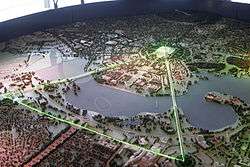Urban planning in Australia
Urban planning in Australia has a significant role to play in ensuring the future sustainability of Australian cities. Australia is one of the most highly urbanised societies in the world. Continued population growth in Australian cities is placing increasing pressure on infrastructure, such as public transport and roadways, energy, air and water systems within the urban environment.
Urban planning is undertaken at all levels of Government in Australia. However, the Federal Government is playing an increasing part in setting policy as part of an overall response to developing climate adaptation and mitigation strategies. The local government has also been engaging with the community to make decisions on urban planning designs that help to promote social cohesion. Over the past few decades Australians have developed a respect for urban heritage places and community groups have fought hard to stop developers from destroying them.
History
Urban planning in Australia has evolved since early British colonial settlement, and has been heavily influenced by contemporary planning movements in Britain, the United States of America and western Europe.[1] However, over the past century, distinctly Australian responses and solutions to Australian urban issues have developed.
The British Colonial Period (1788–1901)
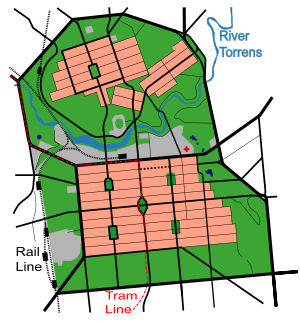
The first examples of town planning in Australia occurred during the early phases of the Colonial era, where critical decisions locked in 'path dependency' for the future form of cities.[2] Typically this involved colonial Governors undertaking surveying for land grants and subdivisions, and making executive decisions on the location and construction of roads, rail transport, water supply and other basic infrastructure to support early penal and military settlements. Primacy was given to the functional and practical needs of Colonial administration, as opposed to more lofty civic or aesthetic ideals.[3]
Despite these humble, utilitarian beginnings, there were places where clear planning and design for settlements occurred. One of the earliest forms of a planned settlement in Australia involved the work of Colonel William Light, a Colonial Surveyor and the Surveyor-General for the colony of South Australia, in planning and designing the original city centre grid for Adelaide in 1837. While Light's plan was not entirely realised, it is widely regarded as a fine achievement of colonial era civic design.[4]
Rapid colonial expansion in the 19th century, matched by economic growth, resulted in Australia becoming one of the most highly urbanised nations in the world. For example, by 1861, 40% of Sydney's residents lived in suburbs.[5] This trend towards urbanisation was established early and continued into the 20th century.
Early 20th century
Australia's rapid urbanization meant urban planning became an increasingly important issue, with the early decades of the century characterised by political, civic and academic discussion around the coordinated planning and administration of rapidly growing metropolitan regions.[6] Early town planners focused on the orderly planning of cities, closely following international contemporary town planning and urban reform movements (especially from the UK), where urban planning aimed to improve urban health, efficiency and aesthetics.[7]
This concern with civic improvement was expressed in many ways, with citizen groups forming in Australian cities to advocate healthier, more beautiful cities.[8] In Sydney, this desire to improve planning found its expression through a Royal Commission into the Improvement of Sydney and its suburbs, which commenced in 1908, focusing on transportation, slum clearance, the future growth of Sydney, and aesthetics.[9] The Garden City movement, founded by Ebenezer Howard in the UK, was also influential and was adopted as a design strategy in several areas of Australian cities (such as in Daceyville in south eastern Sydney).
One of the earliest international contributions made by Australia to urban planning theory and practice resulted from the international competition held to design Australia's new federal capital, Canberra, which was held between 1911 and 1912. The winning design was submitted by American architects Walter Burley Griffin and Marion Mahony Griffin, with the design reflecting state of the art planning concepts from the time. Whilst Canberra was actually constructed some time after the competition, it still represented an early international example of a planned city.
Urban Reform Movement
During this era there were two main approaches to urban reform: a movement towards the creation of a legal framework for town planning, and efforts towards creating large metropolitan governments, known as the 'greater city movement'.[10] The efforts of those advocating for legislative changes led to the establishment of town planning commissions in Sydney (1922), Melbourne (1923) and Perth (1928), and the enactment of the first planning legislation in Australia. These commissions were important developments in the history of Australian town planning, but were ultimately ineffective in achieving town planning objectives.
The greater city movements of Australia[11][12][13] led to the creation of a greater Brisbane (1925), with smaller and more limited successes in Newcastle (1938) and Perth (1914–1917). However, elsewhere the movement was entirely unsuccessful,[14] and following World War II, progress towards metropolitan planning was achieved through the creation of statutory planning agencies under the direction of the state governments. Today, the idea of a single metropolitan municipal government coordinating development and infrastructure is seen as a largely discredited model of urban and regional planning.
The Post World War II period (1945+)
| External video | |
|---|---|
Australian cities and urban centres, particularly capital cities, experienced significant growth after World War II, which was largely driven by a combination of rapid economic expansion, high birth rates and unparalleled levels of immigration, particularly from western Europe and, from the 1970s, south east Asia. Furthermore, increasing ownership of the motor car, combined with cheap fuel, resulted in an explosion in the urban form of many Australian urban centres.[15] Many cities were rapidly transformed from modest, medium density centres, supported by public transport, to a suburban, car dominated city with large, residential dormitory suburbs. As a consequence, population and land use become increasingly dispersed. For example, in 1840 40% of Sydney's residents lived in suburbs, while by the 1960s this figure had risen to over 70%.[16]
Metropolitan planning
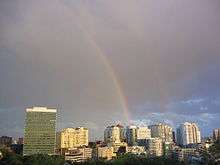
Australia's long period of post war economic growth resulted in Federal and State governments developing metropolitan plans in an attempt to address some of the negative aspects associated with urban growth.[17] Typically, many capital cities engaged in creating metropolitan wide spatial plans to guide development over long periods of up to 20 years or more. Particular focus was given to land release on the Rural-urban fringe, establishing a hierarchy of urban centres, the construction of new public housing estates and a preference towards building car based infrastructure (such as new highways, etc.). Examples include the Sydney County of Cumberland Plan of 1948 (regarded as the first metropolitan plan for Sydney) and the Sydney Region Outline Plan of 1968.
From the early 1970s the Australian Federal Government became directly involved in urban policy with the Whitlam Labour government establishing for the first time a federal Department of Urban and Regional Development.[18] Federal government involvement included taking care of sewage servicing backlogs in major metropolitan centres, the establishment of growth centres and new towns to foster de-centralization, funding infrastructure and public housing.
Australian Planning Frameworks
Urban planning in Australia is a distinct, defined profession, represented by a peak industry group called the Planning Institute of Australia. Similarly, urban planning activities in Australia are codified in law, with a significant body of legislation and case law guiding planning principles and decisions.[19]
Australia's federal system of governance, the nationwide Australian Government, the six states and two territories have their own urban planning laws and procedures resulting in separate systems of planning and land use management, including separate administrative departments that oversee and regulate planning and land use activities.[20] Consequently, there is no single urban planning system for Australia – rather, there are a number of planning systems that operate largely independently of each other along state based lines.[21]
Australian Federal Government
Urban planning is not specifically referred to in the Constitution of Australia as a Federal Government responsibility. Nevertheless, the Federal Government is increasingly playing a role in the urban planning process in Australia, mainly through the regulation of development on areas that are of national environmental significance, or through actual development activities on federal land. Examples of this are where the Federal Government has actively sought to provide strategic guidance and direction in urban policy, starting with the Whitlam Labour Government in the early 1970s, the Building Better Cities Program of the mid-1990s,[22] and, most recently, with the release of a National Urban Policy in 2011. The National Urban Policy was released by the Minister for Infrastructure in 2011 and establishes for the first time the Australian Government's overarching goals for the nation's cities and how to make them more productive and sustainable.[23]
The principal piece of Commonwealth legislation impacting urban planning decisions is the Environment Protection and Biodiversity Conservation Act 1999 which establishes a framework for assessing impacts on threatened species of national significance, world heritage sites, nuclear actions, and national heritage places, amongst other considerations.[24]
New South Wales
Land use planning in New South Wales (NSW) is principally controlled under the provisions of the Environmental Planning and Assessment Act 1979 (EP&A Act). The EP&A Act establishes a number of key planning considerations in NSW, including:
- The role of the Minister for Planning in NSW, as well as the administrative functions of the New South Wales Department of Planning;
- Strategic plan making functions, either through a State Environmental Planning Policy, Local Environmental Plan or Development Control Plan;
- Environmental assessment functions: and
- The role of the Greater Sydney Commission.[25]
In addition to the legislative framework governing land use and urban planning in New South Wales, the Minister for Planning, through the Department of Planning and Infrastructure, publishes a Metropolitan Plan for Sydney, along with Regional Strategies for the Far North Coast, Mid North Coast, Lower Hunter, Illawarra, Sydney to Canberra Corridor, and Murray regions. Whilst not provided for explicitly in the EP&A Act, these strategic planning documents provide a basis for more detailed planning at the Local Government Council, and sub-regional levels (especially in the Sydney Metropolitan Area).
Given that urban planning in NSW is codified through specific legislation, there is a dedicated Land and Environment Court of New South Wales to deal with urban planning disputes. Typically, these most urban planning cases heard by the Land and Environment Court deal with development assessment matters.
Western Australia
In Western Australia urban planning is primarily directed by the Western Australian Planning Commission, a statutory authority of the Government of Western Australia. and implemented by the Department of Planning, Lands & Heritage and local government authorities. Key legislation is the Environmental Protection Act 1986 and the Planning and Development Act 2005.
Challenges
Population growth and demographic change
Population growth and demographic change is a key consideration for Australian urban planning. Data in the 2006 census in Australia indicates that over 75% of all Australians live in 17 cities each with a population size of over 100,000.[26] The five largest cities of Sydney, Melbourne, Brisbane, Perth and Adelaide contain the majority (60.8%) of urban Australians.[26]
According to projections from the Australian Bureau of Statistics and the Department of the Treasury (Australia) it is anticipated that Australia's population will continue growing and will reach 35 million by 2050. It is estimated that 72% of this growth will occur in cities.[26] The Department of the Treasury produced an Intergenerational Report in 2010 which predicts that there will be 8.1 million Australians over the age of 65 years by 2050. This compares to 2.6 million in 2006.[26] This prediction for an aging population in Australia is attributed to low fertility rates and increasing life expectancy.[27]
At the same time it is predicted that households will increase from 7.4 million in 2001 to 10.2 million in 2026 while decline of household size is expected from 2.6 in 2001 to 2.3 in 2026.[26] The composition and size of households varies across Australian cities. A significant proportion of population growth since 2000 has been attributed to overseas immigration to Australia. In 2007–08 the Australian Bureau of Statistics data records that migration contributed 60% of population growth.[28] Long term migration to Australia has meant that 24% of the population was born overseas.[28] The majority of these migrants live in the major cities.[29]
As well as overseas migration some cities are also experiencing internal movement. In 2007–08 New South Wales experienced a net loss of 19,831 whereas Queensland had a net gain of 18,388.[30]
The structure of households within urban cities in Australia has also changed. There is an increasing trend towards couple only, lone parent and single person households with only a marginal increase in parents with children.[31] Despite the trend towards smaller households Australian cities still showed growth in couples with children that was above the overall Australian average. Consequently, cities are still the place where the next generation Australian will be raised.[31]
These demographic changes, in particular the population ageing and increase in smaller households, is leading to a greater demand in urban planning for housing and also different types of housing overall. Some metropolitan areas are experiencing housing shortages, particularly with regards to the provision of affordable accommodation. It is also placing pressure on housing affordability where there is only a single income.[32]
Sustainability
Trends in population growth, transport emissions, energy usage, waste management, urban development, rainfall patterns and extreme weather events (such as droughts, heat waves, severe storms, bushfires, extensive flooding) are highlighting the need for increasing focus on sustainability in Australian cities.
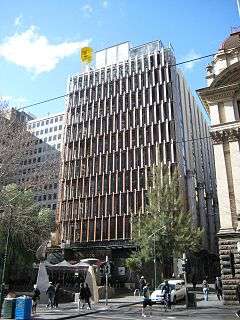
Transport emissions have been reported as one of strongest areas of emissions growth in Australia, which is a consequence of the distance separating many land uses, and of the underlying low density form of many Australian metropolitan areas. Private car use has continued to increase which is leading to greater levels of city congestion and urban air quality challenges.[33] The cost of congestion to the Australia economy was estimated at $9.4 billion in 2005 with a prediction of a rise in cost to $20 billion by 2020 unless the issue is addressed.[34]
Research indicates that while the total levels of key pollutants in cities has fallen over the last ten years as a result of improved fuel and emissions standards, particulate air pollution and ozone levels remain above the national air quality standard.[35]
Rates of recycling nationally have increased, however waste generation has also increased over the period 2002–03 to 2006–07 by 31%. This exceeds the population increase of 5.6% over the same period.[35] As a result, this has placed pressure on governments to adequate plan for landfill and associated waste management facilities in metropolitan areas.
Data on rainfall patterns in eastern and southwest Australia, where the major cities are located, indicates a decline in the annual rate of rainfall per decade of up to 50 mm since 1950.[33] This is providing challenges in terms of both availability and the quality of water supplies, particularly when combined with population growth.
At the planning level basic aspects of sustainable housing design such as raising density, mixed use, promoting mixed use development, and encouraging transit oriented development to increase trips made by public transport have been progressively adopted as policy responses in Australian cities.[36]
Sustainable building codes such as the Victoria's Green Star (Australia) rating and New South Wales' BASIX sustainability assessment tool are being applied to new developments to improve energy and water conservation at the individual building scale.[36]
Further improvements in waste, water, energy and onsite food production are being progressively seen as a necessary and significant part of planning for urban sustainability in Australian cities.[37]
Water sensitive urban design
Water-sensitive urban design (WSUD) has evolved to become a framework for integrating the management of urban water within the practice of sustainable urban design in Australia.[38] Water sensitive design aims to ensure that the management of urban water occurs with sensitivity towards natural water systems and the broader ecosystem that the water systems support.[39]
Within the frame-work planners consider:
- protecting natural systems and water quality through filtration and retention and removal of pollutants close to their source;[40]
- integration of the potable drinking water covering both the piped system from catchments outside the urban area as well as water itself treated to drinking water standard;[38]
- sewerage which encompasses the pipe system for handling the collection and transport of wastewater to treatment plants;[38] and
- Integrated storm water drainage and treatment/re-use as part of the urban landscape.[41]
WSUD incorporates planning and design as it relates to the building and landscape architecture on site and also in the context of wider local and regional initiatives.[42]
Urban renewal and consolidation
Urban renewal and consolidation is changing the character of Australian cities. Planning strategies have focused on containing the outward physical sprawl of cities whilst at the same time emphasis has been placed on redeveloping the inner city and older employment zones as new residential spaces.[43]
A new inner urban city middle class has emerged which has driven the renovation and restoration of the housing stock formally owned by older inner city working class communities.[43] The transformation of these areas has predominantly seen the end of these areas being viewed as places of social disadvantage.[43]
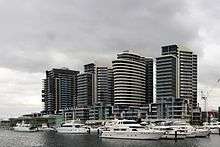
In parallel to the renovation of the housing stock there has also been a revitalization of disused industrial and commercial spaces such as warehouses and docklands and these have been transformed into new residential, commercial and recreational spaces often with high density development.[43] Examples include the Docklands development in Melbourne, Green Square, Victoria Park and Barrangaroo in Sydney and South Bank in Brisbane.
High density living in Australian cities is limited to the inner urban cores of major metropolitan areas, and is substantially less dense than comparable cities in Asia and Europe. Typically most urban housing development focused on a single one level house (although this is changing) on a separate block of land. There has been a small amount of low rise apartments in inner city areas since the 1930s but this started to change since the introduction of Strata Title legislation in the 1960s.[44] The Strata Title legislation enabled individuals to own individual apartments in a multi-apartment block on a single piece of land. Before this apartment blocks were predominantly owned as a single property by landlords.
The introduction of Strata Titles also enabled easier financing arrangements for individuals wishing to purchase a single apartment. Strata titles cover both apartments as well as attached dwellings such as town houses where these have been developed on a single title of land.
Once introduced Strata Titling facilitated the redevelopment, particularly in valuable areas or often close to transport infrastructure, of older housing on larger pieces of land which were replaced with apartment blocks.[44]
Going forward this style of higher density housing is expected to play a large part in meeting housing needs for the changing demographics of an aging population and smaller households in Australian cities.[45] For example, the Sydney Metropolitan Plan 2036 has a growth target of 70% of all new housing to be in the existing urban footprint, with 80% of all housing to be within a 20-minute commute of a major centre. To facilitate this, the Minister for Planning in NSW released an Urban Renewal Planning Policy to specifically deliver urban renewal in key sites in the Sydney Metropolitan area. Several urban renewal projects are planned and underway in Sydney, with the NSW Government unveiling the Greater Sydney Region Plan in 2018 which identifies urban renewal corridors and a vision for three metropolitan cities.[46][47]
Climate Change
Climate change is an important factor in the decision making process for urban planning in Australia because of the highly urbanised population prone to extreme weather patterns. Australia's urban areas are susceptible to changes in the climate because of the physical construction of the built environment, infrastructure, and its ecological correlation with the urban ecosystem.[48] Over 80% of the Australian population lives in the coastal area of Australia and many on the fringe of bush land and rivers making them vulnerable to the effects of climate change. These effects include sea level rise, increased storm surges resulting in coastal erosion, strong winds, intense rainfall causing flash flooding and bushfires due to increased temperatures.[49] The Australian Federal Government is in the process of developing climate adaptation and mitigation strategies along with risk assessment analysis initiatives to urban planning.[48]
Historically urban planning has been the role of the state, regional and local governments but since December 2009 the Australian Federal Government has re-engaged in a strategic decision making process to prepare for climate change. The Department of Climate Change and Energy Efficiency (DCCEE) has developed adaption programs and risk assessments.[49] A risk assessment has been calculated for possible effects on urban areas due to climate change and replacement values for transport, industrial, residential and commercial infrastructure runs into billions of dollars.[50] Therefore, avoidance of future risk is the most cost-effective approach to urban planning.[49]
The options for coastal and riverside management to deal with sea level rise and storm surges fall into three categories; "retreat", "accommodate" and "protect".[51] "Retreat" entails relocating coastal and riverside infrastructure that are high risk of damage from extreme weather patterns, as well as designing buildings and infrastructures in new locations away from potential risk areas.[51] "Accommodate" means adapting the existing built environments to effectively cope with the changing conditions such as Island raising through adding sand to beaches and raising infrastructure and buildings near the coast and riverside. "Protect" involves building sea walls and levees to prevent damage from storm surges and sea level rise.[52]
There are a number of simple but effective adaptation options possible at a local scale to deal with intense rainfall and temperature rises. These include reducing impervious surfaces to allow for water infiltration, tree planting in urban areas to reduce the "heat island effect" and constructing transport facilities away from flood areas. Designing buildings with natural ventilation and building insulation will also help with increasing temperatures. While the only possible solution to bushfires might be to increase fire breaks between the houses and bush land.[51]
Heritage and Conservation
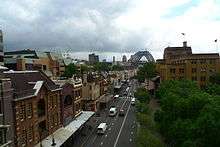
Politicians, planners and the community came to see the value of heritage buildings in Australia only recently in the 1970s.[53] Laws and policies are now in place to conserve and protect historic buildings across Australia. The Green Ban is a key aspect in the initiation of these regulations especially the impact it had on proposed urban development in the city of Sydney.[54]
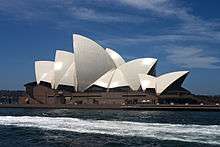
In the early twentieth century there was no historic sense of preservation with regard to the built environment and people were happy to see the old replaced by the new. Then in the 1970s came the Green Bans movement imposed by builders labourers across Australia, being particularly prominent in Sydney.[54] The Green Ban was created to defend the demolition of older style buildings that were to make way for new developments of skyscrapers, shopping precincts and luxury apartments. It was initiated by the builders labourers that were hired to construct these new buildings and was the first of its kind around the world.[54] The key element of the movement came from the New South Wales Builders Labourers Federation (NSWBLF) which consisted of over 100 union members that belonged to the Communist Party of Australia. The most famous union leaders of the NSWBLF were Bob Pringle, Joe Owens and Jack Mundey. Many critics of the union disputed that they were denying workers employment but the union responded that they wanted to build but in a way that enhanced the built environment, such as schools and houses for the everyday person not buildings based on developers' needs.[55] Among the 40 green bans imposed in NSW, The Rocks in Sydney was the most significant areas saved. The green ban prevented the demolition of some of the oldest buildings in Australia and beautiful foreshore parks which were going to be replaced by concrete, glass office blocks.[54]
States and territories of Australia have since implemented heritage acts and have heritage frameworks in place to protect buildings and places of cultural significance.[53] On a national scale in 1999 the Environment Protection and Biodiversity Conservation Act was introduced which outlines a National Heritage List (NHL).[56] The NHL is in place to protect "exceptional natural and cultural places that contribute to Australia's national identity".[57] Since then measurements of heritage have evolved and in 2011, there are 113 places listed of iconic heritage value to the whole of Australia, which include the Sydney Opera House, Melbourne Cricket Ground and Anzac Parade in Canberra.[58]
Urban planning in Australia in the 21st century now has very strict guidelines to follow and heritage is of fundamental significance in the decision making process before any construction takes place. As developers now know there will always be people watching and ready to protect Australia's cultural history.
Community Participation
The Australian government has begun to see community engagement in the decision making process of urban planning of fundamental importance. Due to this engagement local governments have looked for ways to design urban infrastructure in a way that helps to encourage social cohesion. However, there is still room for developing a method that uses community involvement more effectively. Community participation has also created many barriers along the way by preventing urban planning projects from proceeding.[59]
Previously, urban planning in Australia quite often did not involve the community and projects went ahead to construct residential buildings that were crammed into small areas and did not provide space for recreation and socialising. Recently this approach has changed and planners have realised the importance of creating an urban environment that encourages social behavior among its residents.[60] These new designs incorporate active living and recreational areas that provide for social connectivity and wellbeing. This new approach has come through feedback from the community showing the positive effects of their involvement.[60]
In 2008, the Australian federal government headed by former Prime Minister Kevin Rudd inaugurated the Department of Infrastructure and Transport to work with the newly established Major Cities Unit (MCU)in an effort to involve the community to develop urban environments into more productive and sustainable places.[60] From then on the MCU has been researching ways to develop policies that improve urban planning to make cities more socially inclusive and encouraging the community to actively participate in the decision making process.[61] In May 2011, national urban new policies were released by the Minister for Infrastructure and Transport, Anthony Albanese which promised to: "enhance the livability of cities by promoting better urban design, planning and affordable access to recreational, cultural and community facilities." [62]
There is still a need to develop more effective participation from the community. Often the participants do not represent the views of the whole community and disadvantaged groups such as the poor and minorities do not get a fair say in the urban planning process.[63]
Integrating Land Use and Public Transport
Australia's urban transport system could become under increasing demand as the population grows and Australia moves to a more environmentally friendly urban system. Some of Australia's urban problems such as road congestion and pollution could be solved by the improvement of public transport, as it is a crucial aspect in creating a functional, sustainable city.[64] The urban structure of Australian cities consists of dispersed suburbs and dense central building districts which creates immense planning challenges for decision makers.[64] Urban planners now realise the need to integrate active and sustainable public transport with destinations accessible to alternative modes of transport such as cycling and walking to encourage people to reduce the stress of cars on the roads.[65]
Road transport contributes to 88% of all transport emissions and the cities of Australia are congested not only by automobiles but the parking lots they use.[66] In March 2006, 75% of adults in Australian cities travelled to work or study by private automobile in comparison to 19% that used public transport and 5% that walked or cycled.[67] Reducing private automobile dependence will improve the pollution problem and free up land to build more needed infrastructure such as schools, houses and hospitals. To encourage Australians to use public transport research suggests it should be more efficient (timely, reliable, and accessible) and affordable.[68]
The Australian Transport Council has found that the current networks of buses and trains in Australian cities need to be integrated with effective land use.[69] At the moment buses and trains run along the same routes competing with each other. Ideally trains are used to travel long distances, with a high passenger capacity and avoid the traffic signals. Buses should be in place as an intermediary for fast inner city train networks and for passengers to access surrounding suburbs not suitable for trains.[64] Land use integration would mean that urban planners design infrastructure around public transport to enable the public to have access to transport within close walking distance from their home or work.[69] Some urban planners and policy makers think there is a need to remove car parks, build upon current transport infrastructure to create a more efficient system that facilitates urban regeneration.[69]
Notes
- Freestone 2007 p. 67
- Troy 1995 p. 15
- Freestone 2007 p.68
- Bunker 1997 p. 244
- Steele & Gleeson, 2010 p. 305
- Christine, Garnaut (2000). "Towards metropolitan organisation: Town planning and the garden city idea". In Hamnett, Stephen; Freestone, Robert (eds.). The Australian metropolis: a planning history. New South Wales: Allen & Unwin. ISBN 1865080535.
- Toon & Falk 2003 p. 4
- Bonyhardy 2000 p. 21
- Freestone and Ashton 2008
- Minnery, John (July 14 2004). 'The wonderful possibilities of the future’: Political and administrative influences on urban planning in Greater Brisbane. International Planning History Conference Barcelona.
- "The Greater Sydney Movement". The Sydney Morning Herald. 12 April 1900.
- "Greater Perth Movement". The West Australian. 10 November 1914. p. 5.
- "Greater Adelaide". Port Pirie Recorder and North Western Mail. 18 March 1911.
- Minnery, John (November 2014). "Off the Shelf or Tailor Made? Sources of Ideas for the Creation of Greater Brisbane in 1924". International Journal of Regional and Local History. 9 (2): 107–122. doi:10.1179/2051453014Z.00000000018.
- Owen 2010 p. 143
- Steele & Gleeson 2010 p. 305
- Yiftachel 1989 p. 29
- Freestone 2007 p. 79
- Williams, 2007 p. 93
- Farrier et al 2009 p. ix
- Williams 2007 p. 94
- Freestone 2007 p. 87
- DIT, 2011
- DSEWPC, 2011
- http://www.austlii.edu.au/au/legis/nsw/consol_act/epaaa1979389/s53a.html
- DIT, 2010, p.28.
- Hugo, 1974, p.24.
- DIT, 2010, p.33.
- DIT, 2010, p.34.
- DIT, 2010, p.36.
- Randolph, 2004, p.484.
- Randolph, 2004, p.485.
- DIT, 2010, p.70
- "Australia faces $20 billion road congestion problem". news.com.au. News Limited. 5 March 2010. Retrieved 25 September 2011.
- DIT, 2010, p.71
- Crabtree, 2005, p.333
- DSEWPC, 2002, p.4.
- Wong, 2006, p.213.
- AGNWC, 2010
- Melbourne Water, n.d.
- Wong, 2006, An Overview, p.2.
- Wong, Water sensitive urban design, 2006, p.214.
- Randolph, 2004, p.487
- Randolph, 2006, p.474.
- Hugo, 2010, p.41.
- "Changing urban precincts - City of Sydney". www.cityofsydney.nsw.gov.au. Retrieved 2020-02-13.
- "Vision of A Metropolis of Three Cities | Greater Sydney Commission". www.greater.sydney. Retrieved 2020-02-13.
- Bambrick et al. 2011, p.68S.
- Norman, 2010
- DCCEE 2011
- Thom et al. 2009
- Walsh et al. 2004, p.595.
- Freestone 1993, p.18.
- Burgmann M & Burgmann V 2011
- Burgmann V 1993
- Freestone, Marsden & Garnaut 2008, p.158.
- DSEWPC, 2011, National heritage
- DSEWPC, 2011, Find places on the national heritage list
- Mahjabeen & Shrestha, n.d., p.21
- Department of Parliamentary Services, 2010
- Urban Design Forum 2011
- Urban Analyst 2011
- Mahjabeen, Shrestha, Dee 2008, p.168.
- Mees & Dodson 2011
- Thinking Transport, n.d.
- Tiwari, Cervero & Schipper 2011, p.394
- ABS 2009
- Bambrick et al. 2011, p.71S
- ATC, 2003
123123123
References
- Australian Bureau of Statistics (ABS) 2008. Australian social trends: population distribution, Australia, 2008, Cat. no. 4102.0, ABS, Canberra. [Accessed 17 September 2011]
- Australian Bureau of Statistics (ABS) 2009. Australian social trends: public transport use for work and study, Australia, 2009, Cat. no. 4102.0, ABS, Canberra. [Accessed 15 September 2011]
- Australian Transport Council (ATC) 2003. National charter of integrated land use and transport Planning, AGPS, Canberra. [Accessed 14 September 2011]
- Australian Transport Council (ATC) 2006. National guidelines for transport system management in Australia, AGPS, Canberra.
- Burgmann M & Burgmann V 2011. Green bans movement, Dictionary of Sydney. 18 September 2011.
- Bambrick H J, Capon A G, Barnett G B, Beaty R M & Burton A J 2011. Climate change and health in the urban environment: adaptation opportunities in Australian cities, Asia-Pacific Journal of Public Health, 23: 2, 67S-79S.
- Bonyhardy T 2000. The Colonial Earth, Melbourne, The Miegunyah Press
- Brand D 1998. 'An urbane gaol: Macquarie's Sydney', Journal of Urban Design 3:225–240
- Bunker R 1997. 'Process and product in the foundation and laying out of Adelaide' in Urban Policy and Research, 21, 243–255
- Burgmann V 1993. Reshaping cultural values: a perspective on Sydney’s green ban campaign, 1970–74, Power & Protest.
- Crabtree L 2005. Sustainable Housing Development in Urban Australia: exploring obstacles to and opportunities for ecocity efforts, Australian Geographer, 36:3, p. 333-350
- Department of Climate Change and Energy Efficiency (DCCEE) 2011. Climate change risks to coastal buildings and infrastructure: a supplement to the first pass national assessment, Department Climate Change Energy Efficiency.
- Department of Infrastructure and Transport (DIT) 2010. Major Cities Unit, State of Australian Cities Report 2010, p. 28, [referenced on 11 September 2011]
- Department of Infrastructure and Transport (DIT) National Urban Policy 2011.
- Department of Planning and Infrastructure (DP&I) 2011.
- Department of Sustainability, Environment, Water, Population and Communities (DSEWPC) (2011)
- Department of Parliamentary Services 2010. Of the plan: Commonwealth city planning systems, Australian Parliamentary Library Information Analysis Advice.
- Department of Sustainability, Environment, Water, Population and Communities (DSEWPC) 2002. World summit on sustainable development: Australian national assessment report 2002 p 4 [accessed 11 September 2011]
- Department of Sustainability Environment, Water, Population & Communities (DSEWPC) 2011. Find places on the national heritage list, Australian Government. 12 September 2011.
- Department of Sustainability Environment, Water, Population & Communities (DSEWPC) 2011. National heritage, Australian Government. website
- Freestone R 1993. Heritage, urban planning, and the postmodern city, Australian Geographer, 24:1, 17–24.
- Freestone R Marsden S & Garnaut C 2008. A methodology for assessing the heritage of planned urban environments: an Australian study of national heritage values, International Journal of Heritage Studies, 14:2, 156–175.
- Farrier D et al. 2009. The Environmental Law Handbook, Redfern Legal Centre, Sydney.
- Freestone R and Ashton R 2008. Sydney Planning History, in Dictionary of Sydney
- Freestone R 2007 A History of Planning in, Thompson, S (Ed) (2007) Planning in Australia: An overview of urban and regional planning, Cambridge.
- Gleeson B and Low N 2000. Australian Urban Planning: New Challenges, New Agendas, Allen and Unwin.
- Hugo G 1987. Ageing in Australia: the Spatial Implications, Urban Policy and Research, 5:1, 24–26
- Hugo G 2010. Implications of demographic change for future housing demand in Australia, Australian Planner, 42:2, p. 33-41
- Mahjabeen Z & Shrestha K K (n.d.). Social Justice and City: community participation in Sydney’s metropolitan planning. p. 1-25.
- Mahjabeen Z, Shrestha K K, Dee J A 2008, Rethinking community participation in urban planning: the role of disadvantaged groups in Sydney metropolitan strategy, Proceedings of 32nd ANZRSAI Conference, 167–185.
- Mcdonald J 2011. Hot in the city: planning for climate change impacts in urban Australia,
- McManus P 1994. Integrating community-development and urban-planning in Western-Australia, Community Development Journal, 29:1, 15–20.
- Mees P & Dodson J 2011. Public transport network planning in Australia: assessing current practice in Australia’s five largest cities, Research Paper 34, Urban Research Program, Griffith University.
- Melbourne Water 2010. Water sensitive urban design. [accessed 11 September 2011]
- National Water Commission. Water-sensitive urban design, Canberra. [Accessed 18 September 2011]
- Norman B 2010. A low carbon and resilient urban future: an integrated approach to planning for climate change, Department of Climate Change and Energy Efficiency, Urban & Regional Planning, University of Canberra.
- Orchard L 1999. Shifting Visions in national urban and regional policy, in Australian Planner, 36, 20–25
- Owen D 2010. Green Metropolis – Why Living Smaller, Living Closer, and driving Less Are the Keys to Sustainability, Penguin
- Randolph B 2004. The Changing Australian City: New Patterns, New Policies and New Research Needs, Urban Policy and Research, 22:4, 481–493
- Randolph B 2006. Delivering the Compact City in Australia: Current Trends and Future Implications, Urban Policy and Research, 24:4, p. 474-490
- Steele W E & Gleeson B 2010. Mind the gap – Oil vulnerability and urban resilience in Australian cities in Australian Planner 47:4, 302–310.
- Thinking Transport (n.d). Principles of Integrated Transport and Mobility No. 4: land use.
- Thom B, Cane J, Cox R, Farrell C, Hayes P, Kay R, Kearns A, Choy D L, McAneney J, McDonald J, Nolan M, Norman B, Nott J, Smith T 2009. National climate change adaptation research plan: settlements and infrastructure, National Climate Change Adaption Research Facility, AGPS, Canberra.
- Tiwari R, Cervero R & Schipper L 2011. Driving CO2 reduction by Integrating Transport and Urban Design strategies, International Journal of Policy & Planning, 28: 5, 394–405.
- Toon J & Falk J 2003. Sydney: Planning or politics – town planning for the Sydney region since 1945, Planning Research Centre, Sydney University.
- Troy P 1995. Technological Change and the City, Sydney, Federation Press.
- Urban Analyst 2011. National urban policy released. 17 September 2011.
- Urban Design Forum 2011. Major cities unit. 15 September 2011.
- Walsh K J E, Betts H, Church J, Pittock A B, McInnes K L, Jackett D R, & McDougall T J 2004. Using Sea Level Rise Projections for Urban Planning in Australia, Journal of Coastal Research, 20:2, 586–598.
- Williams, P 2007. 'Planning and the legislative framework' in Thompson, S (Ed) (2007) Planning in Australia: An overview of urban and regional planning, Cambridge.
- Wong T 2006. An Overview of Water Sensitive Urban Design Practices in Australia, Water Practice and Technology, 1:1, p 1-8
- Wong T 2006. Water Sensitive Urban Design – the Journey thus Far, Australian Journal of Water Resources, 1:10:3 p. 213-222
- Yiftachel O 1989. 'Towards a new typology of urban planning theories' in Planning and Environment B: Planning and Design 16, 23–39.
Further reading
- Bunker R (2009) Situating Australian Metropolitan Planning, International Planning Studies, 14:3 233–252
- Forster C (2006). The challenge of change: Australian cities and urban planning in the new millennium, Geographical Research, 44:2 p 173-182
- Gleeson B (2000). New challenges, new agendas for Australia's cities, International Planning Studies, 5:3, 269–271
External links
- Planning Institute of Australia
- Planning in South Australia, South Australian Government's Department of Planning and Local Government site
